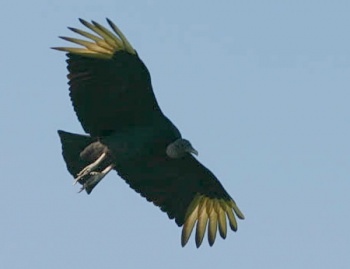Disambiguation: For the European and Asian species Aegypius monachus, see Cinereous Vulture.
Alternative name: American Black Vulture
- Coragyps atratus
Identification
56–74 cm (22-29 in); Average females can weigh up to 2 kg, males are slightly heavier.
This New World vulture is entirely black, except for a pale patch on the outer primaries on the under- and upperwings. Its head is unfeathered and somewhat paler than the body and its tail is very short.

Photo © by Michael W
Everglades National Park, Florida, United States, 12 December 2003
Similar Species
The Black Vulture can be mistaken with the Turkey Vulture (Cathartes aura), but they are easily separated by:
- head: greyish in Black Vulture and red in Turkey (but juv. Turkey with grey head).
- underwing: Turkey's has pale secondaries and primaries, contrasting with the dark underwing coverts.
- tail: longer in Turkey (make wings appear narrower).
Another good way to distinguish them is the flight: Black Vultures beat their wings more often than Turkey when in flight. Above mentioned features are also useful for separating the Black Vulture from the Lesser Yellow-headed and Greater Yellow-headed Vultures, except that they have mainly yellow heads as adults. The pale patch in the primaries vaguely resemble that in the Crested Caracara (Caracara plancus), but remaining plumage and wing and tail shape easily separate them.
Distribution
The Black Vulture is very widespread and common, being found throughout almost whole South America, except for far south, Central America, Mexico and southern and eastern United States. Has been recorded as a vagrant on Cuba and the southern Lesser Antilles.
Taxonomy
Subspecies
Three subspecies exist[1], but they are not always recognised. Howard & Moore checklist, for example, consider C. atratus monotypic.
- C. a. atratus (North American Black Vulture): Extreme Southern USA and northern Mexico.
- C. a. brasiliensis (South American Black Vulture): Central America to northern and eastern South America
- C. a. foetens (Andean Black Vulture): Western South America
Habitat
It lives in a wide range of habitats from deserts and grasslands to woodland and forest, but the last is often avoided. They are mostly found in open areas, being very common in big cities, e.g. Sao Paulo and Rio de Janeiro, Brazil.
Behaviour
Flight Action
This vulture, as well as some others, soars high with wings held in dihedral, in large groups or pairs, searching for thermal currents. Hundreds of individuals are seen soaring and perched on trashpiles, which together with the ability to nest on skycrapers, makes this species one of the most adaptable to human life. They are often seen taking sun baths with the wings spread.
Diet
They search for food by eyesight their diet consists mostly of carcasses, but they can feed, in lesser scale, on insects, small mammals, reptiles and eggs.
References
- Clements, J. F., P. C. Rasmussen, T. S. Schulenberg, M. J. Iliff, T. A. Fredericks, J. A. Gerbracht, D. Lepage, A. Spencer, S. M. Billerman, B. L. Sullivan, M. Smith, and C. L. Wood. 2024. The eBird/Clements checklist of Birds of the World: v2024. Downloaded from https://www.birds.cornell.edu/clementschecklist/download/
- Buckley, N. J. (2020). Black Vulture (Coragyps atratus), version 1.0. In Birds of the World (A. F. Poole and F. B. Gill, Editors). Cornell Lab of Ornithology, Ithaca, NY, USA. https://doi.org/10.2173/bow.blkvul.01
- Buckley, N. J. (1999). Black Vulture (Coragyps atratus), version 2.0. In The Birds of North America (A. F. Poole and F. B. Gill, Editors). Cornell Lab of Ornithology, Ithaca, NY, USA. https://doi.org/10.2173/bna.411
Recommended Citation
- BirdForum Opus contributors. (2025) Black Vulture. In: BirdForum, the forum for wild birds and birding. Retrieved 17 May 2025 from https://www.birdforum.net/opus/Black_Vulture
External Links
GSearch checked for 2020 platform.1





